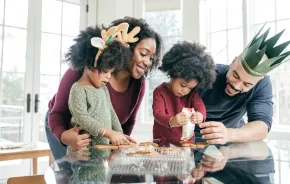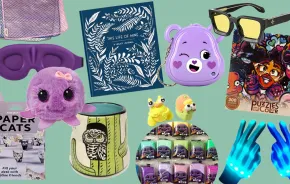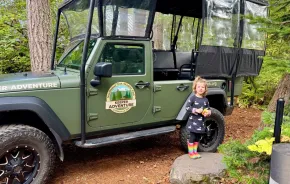With the holiday gift-hunting season approaching, many parents face the challenge of finding toys that will be accessible and enjoyable to a child with a disability. The good news is, wonderful resources are available to help.
People toy shopping for kids with special needs often turn to companies selling specially marketed "adapted" toys. While these can be a good option, they are frequently higher-priced than comparable off-the-shelf toys, and mainly available though mail-order catalogs, which makes them difficult to sample. Adapted toys can also be limiting in that they set kids with disabilities apart from siblings and friends who are typically developing. When kids with special needs can interact with others using the same toys, it allows them to experience important feelings of connection and normalcy.
As longtime head buyer and manager of Top Ten Toys in Seattle's Greenwood neighborhood, Kathie Dockstader has sampled and evaluated a lifetime's worth of toys and creative materials for kids. Dockstader believes that there is an abundance of good toys to be found at any specialty (non-mass-market) toy store anywhere for kids with special needs. The key, she says, is to give families of such kids, as well as toy retailers and their employees, the tools and information they need to work together in making good choices.
With this mission in mind -- and the support of Top Ten Toys owner Allen Rickert -- Dockstader, along with collaborator Joan Machlis (co-owner of Wind-Up Here, in Olympia) and other toy industry colleagues, launched a program called Good to Grow in summer 2005. Initial funding was provided by U.S. Sen. Patty Murray, who helped facilitate an economic development grant for the project as part of her commitment to child and family welfare.
Good to Grow is designed to help specialty toy stores and their customers match toys to children with special needs. Through this program, occupational therapists from the Washington Elks Therapy Program for Children have tested several hundred toys with kids with disabilities and recorded their observations and ratings. Each toy is evaluated based on criteria including how open-ended it is, whether it can be used in various settings and from a range of positions, and -- of course -- the fun factor. The therapists' recommendations are viewable by retailers and customers on the Good to Grow Web site (www.goodtogrowtoys.com).
"Our goal is to give parents of kids with special needs a resource that allows them to go to their local specialty toy store anywhere in the country and find great toy options for their kids," Dockstader says. "We've tried to focus on toys that any local retailer would carry, from the smallest store to the largest."
Visitors to the site can search for toys by a specific skill they are looking to develop, by price range or manufacturer, or by type of disability. This unique resource provides not only help in selecting toys for kids with a wide range of disabilities, but also priceless tips on getting the most developmental and social value out of a toy. In the future, Good to Grow plans to add reviews of hundreds more toys, along with musical instruments, games, and other creative playthings.
Dockstader sees Good to Grow as a conversation starter between toy retailers and customers who are toy shopping for kids with disabilities -- a tool to help facilitate the collaboration. The site includes descriptions of a large number of disabilities, so retail staff can help familiarize themselves with customers' needs. "We've found that parents often don't know how to ask for what they're looking for, and retailers don't know how to respond," she says.
Jude LaRene, owner of Izilla Toys in Seattle's Madison Valley neighborhood, also emphasizes the collaboration involved in matching toys to kids with disabilities. "We have to listen carefully to the parents, teachers and therapists who come in asking for toys to meet specific needs, and to be very familiar with our stock and what we can get," LaRene says. "Parents often come in with an amorphous idea about what they need, and we try to give them options. Sometimes it takes a little detective work. We encourage them to bring their kids in, open a box and see what happens." In his recommendations, LaRene looks for toys "that address each child and family as individuals; what might be a puzzle to one child could be a cooperative game to another family."
LaRene also looks to companies that sell adapted toys for inspiration: "They may have a toy listed as appropriate for situations that never occurred to me, or might prompt me to find a toy that fulfills similar needs but isn't quite as pricey." Two Web sites he consults frequently are Dragonfly Toys (www.dragonflytoys.com) and TFH Special Needs Toys (www.specialneedstoys.com).
Dockstader sees Good to Grow's toy evaluations as a useful resource for all toy consumers, not only those buying for kids with special conditions. Just as with kids with special needs, there are no one-size-fits-all criteria in selecting toys for typically developing kids: In each case, it's about finding the right fit. Also, according to Dockstader and LaRene, toys that tend to be successful for kids with special needs are generally ones that meet high standards of overall quality, making them a good choice for kids of all kinds.
Allison Dworkin, ParentMap's special projects editor, lives in Seattle and has two daughters.
10 tips for selecting special-needs toys
The National Lekotek Center is a non-profit organization with a national network of affiliates dedicated to making play and learning accessible for children with disabilities and providing supportive services for their families.
According to Diana Nielander, Lekotek's executive director, "Toys are the most important tools for kids -- and kids with special needs are no exception. We believe that when a child has access to toys and games, it makes it easier for the child to move beyond the disability and what he or she cannot do, and reinforce -and marvel -- at what he or she can."
The Lekotek Center offers the following 10 tips to consider when selecting toys for a child with a disability:
1. Multi-sensory appeal
- Does the toy respond with lights, sounds or movement to engage the child? Are there contrasting colors? Does it have a scent? Is there texture?
2. Method of activation
- Will the toy provide a challenge without frustration? What is the force required to activate? What are the number and complexity of steps required to activate?
3. Places the toy will be used
- Will the toy be easy to store? Is there space in the home? Can the toy be used in a variety of positions such as side-lying or on a wheelchair tray?
4. Opportunities for success
- Can play be open-ended with no definite right or wrong way? Is it adaptable to the child's individual style, ability and pace?
5. Current popularity
- Is it a toy that will help the child with disabilities feel like "any other kid?" Does it tie in with other activities like books and art sets that promote other forms of play?
6. Self-expression
- Does the toy allow for creativity, uniqueness and making choices? Will it give the child experience with a variety of media?
7. Adjustability
- Does it have adjustable height, sound volume, speed and level of difficulty?
8. Child's individual abilities
- Does the toy provide activities that reflect both developmental and chronological ages? Does it reflect the child's interests and age?
9. Safety and durability
- Does the toy fit with the child's size and strength? Does it have moisture resistance? Are the toy and its parts sized appropriately? Can it be washed and cleaned?
10. Potential for interaction
- Will the child be an active participant during use? Will the toy encourage social engagement with others?
For additional information on toys, play and technology for children with disabilities, visit www.lekotek.org, email lekotek@lekotek.org or call the Lekotek Toy Resource Helpline at 1-800-366-PLAY. National Lekotek Center is a division of the Anixter Center, www.anixter.org.









